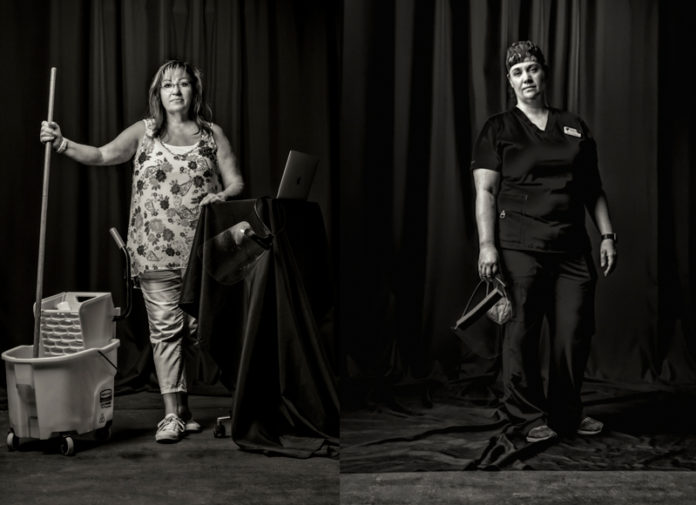Creating the Book “Essentials”
by
Malinda Julien
“Non-Essential” Those words created a deep reflex in me, a term I was not used to hearing, especially during a crisis situation. For 20 years, I was a first responder… instructor and owner of US Tactical K9 Law Enforcement Academy and used to being hot on the phone, loading palletized items, and gearing up K9s to hit the road in 20 minutes.
But the fall of 2019 brought a stark reality of how useless I had become. Our studio was completely shut down, all money had stopped, and we were afraid to see our own family.
Having retired in 2014, I was now labeled “non-essential.” The concept was painful and lonely. How could I, as a photographer, become essential in this unprecedented time?
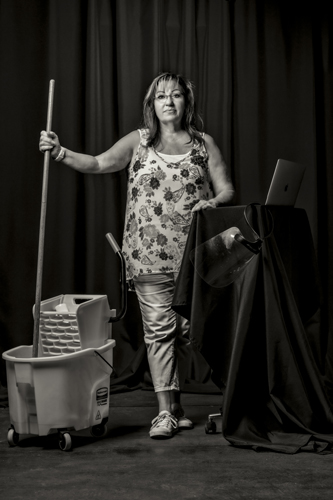 The fact is that photographers are the historians of the world, so I decided to become exactly that, the historian of the real heroes of this shattering pandemic in our City. My book “Essentials” became my months long effort. With the support from our City, local leaders and friends, we were able to locate those who might otherwise go unnoticed.
The fact is that photographers are the historians of the world, so I decided to become exactly that, the historian of the real heroes of this shattering pandemic in our City. My book “Essentials” became my months long effort. With the support from our City, local leaders and friends, we were able to locate those who might otherwise go unnoticed.
They were workers in an uncertain world, not knowing exactly how this virus spreads or if there will ever be a cure, who had to do the work we depend on for our own existence. These everyday heroes ran our grocery stores, kept the post office open and running, fixed the City vehicles to keep them running, took care of the children of the first responders… and the list goes on and on.
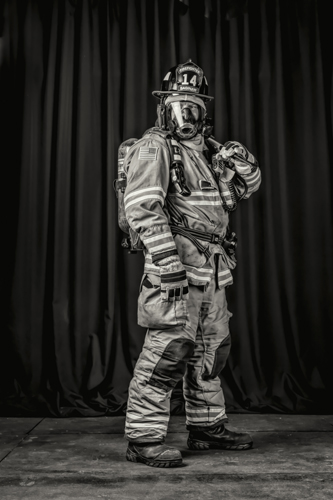 The list included City Police, Fire and all Emergency services working long hours and not knowing if they were bringing the virus home to their families. They also included medical personnel, working days on end with no information about the virus, trying to keep the emergencies under control. It was a long list of people who don’t feel like they are heroes, and are hard to bring forefront to be photographed and recorded in word. They are happy to work, silently and without thanks, in the background where you don’t even realize they are there.
The list included City Police, Fire and all Emergency services working long hours and not knowing if they were bringing the virus home to their families. They also included medical personnel, working days on end with no information about the virus, trying to keep the emergencies under control. It was a long list of people who don’t feel like they are heroes, and are hard to bring forefront to be photographed and recorded in word. They are happy to work, silently and without thanks, in the background where you don’t even realize they are there.
Images for the book “Essential” are the “heroes” of Saginaw, Texas. To portray their role during the Pandemic, subjects needed to be raw, unscripted and unassuming. Photographs of them had to match the participant’s words, humble and unassuming.
Despite the unposed and unscripted subjects, the book had to look professionally created and done with a theme. Creating the same image at different times, sometimes at the last minute, with people who live and work in the background of all our lives was a dedicated labor of love.
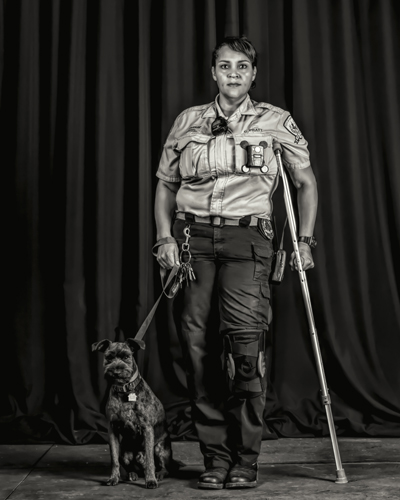 The rule for each subject was “Come as you are after a hard day of work.” Photographs were taken during the first few months of the never-ending COVID-19 pandemic. We only took about 10 minutes with each subject, asking them to stand and look “how they felt.”
The rule for each subject was “Come as you are after a hard day of work.” Photographs were taken during the first few months of the never-ending COVID-19 pandemic. We only took about 10 minutes with each subject, asking them to stand and look “how they felt.”
All images were taken with the Canon 5D SR, at ISO 100, f5.6, through a Canon 24-70mm f2.8L II USM lens with a PolorPro ND filter. The camera was mounted on a large Cambo camera stand, tethered to a MacBook Pro laptop which was on a Tether Tools™ table system.
We used a Sekonic LiteMaster Pro L-478D light meter to meter each light separately and then as a final setting, trying to keep our exposures and look consistent. Each shot started with an X-Rite ColorChecker Passport Photo 2 to keep our colors consistent. Color, even in black-and-white imagery, was important because, at the time, we didn’t know where we would go with the book.
The lighting consisted of three Flashpoint XPLOR 600PRO TTL flash heads, with main and fill both GOBO’d with Westcott Softbox 3×4 white interior with 40º eggcrate grids and a top light with a Westcott 1×2 soft box silver interior to give a little bite to the background. The grids on the soft boxes were necessary to keep the light on my subject. The main light was at 1/32nd power.
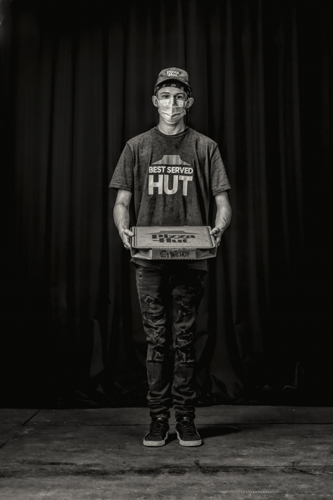 The studio setup was where architecture and product photography workflows aided in the ease of continuity. Each aspect of location, height, and angle of the camera, lens length, lighting placement and exposure had to be marked and recorded to be matched between each shot. Our studio set up changes for each client or product, so it had to be moved quickly back into place and always be consistent.
The studio setup was where architecture and product photography workflows aided in the ease of continuity. Each aspect of location, height, and angle of the camera, lens length, lighting placement and exposure had to be marked and recorded to be matched between each shot. Our studio set up changes for each client or product, so it had to be moved quickly back into place and always be consistent.
Using gaffer’s tape on the floor to mark locations of lights and camera stand, we then took measurements from floor to light head for each head and recorded them on painters tape on each light stand. The camera was always leveled using the built in leveling feature. The lens direction was measured at 90º using a pen laser from lens to white board where the subject would be. This could be altered to give a larger than life view shooting slightly upward at the subject but gave us a steady starting place for each shot. For added insurance, we took an iPhone™ photo of the setup just to ensure we had it all the same and if another one of our photographers had to shoot a portrait, it would be seamless.
Originally, I chose a landscape orientation for a couple of reasons. First, it gave me more latitude in where to place the copy with the image. Secondly, producing any type of video using the images, horizontal would always work. The horizontal orientation also gave me the latitude to move the subject around and have negative space for copy or effect. The final book, however, ended up being portrait orientation. But the camera resolution was clear enough to make the crop.
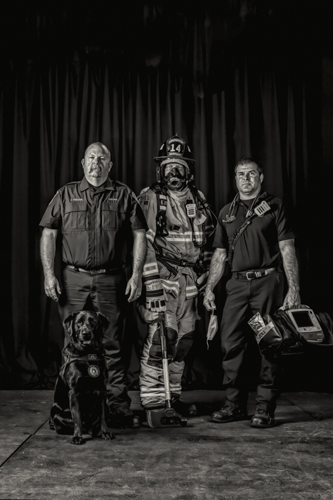 The black-and-white contrasty image, we felt, lent to the reality of their work. These images were processed into black and white using Adobe Lightroom and Adobe Photoshop. There was no retouching or photoshopping done other than the B/W conversion and some clarity. We wanted the subject to be first and foremost and not the color.
The black-and-white contrasty image, we felt, lent to the reality of their work. These images were processed into black and white using Adobe Lightroom and Adobe Photoshop. There was no retouching or photoshopping done other than the B/W conversion and some clarity. We wanted the subject to be first and foremost and not the color.
Post Processing is always Adobe Lightroom. We live-tether from our camera to view on the laptop and that is mirrored to a 65” Sony monitor so everyone involved can view and have input into the image. It was important for the subjects to be an integral part of the image choice. This also allowed us to check focus and exposure on a very detailed level. We only had one chance to get these images.
In Lightroom, we adjusted the exposure, shadows, and highlights. From there, images went directly to Photoshop to adjust the black and white. We did not do any retouching because the images were “editorial” and had to stay the way they actually looked. Once back to Lightroom, we increased the clarity of the image by an average of +8. This decision was made after several days of discussion to add to the grittiness of the image.
It was hard to know when to stop or how to decide if we had included everyone. After some discussion, the consensus was that we had done enough. There would always be more people who went unnoticed and for that we lamented. The book was published in October of 2020 in portrait and large format, made available through our website, studio and Amazon. Copies were also donated to our local library.
I guess “Essential” is just a matter of perspective. From a badge to a light meter, we are a different kind of first responder. To say I was humbled by the experience, being on the other side, would be a vast understatement. Did I save a life? No. Did I rescue someone? No. Did I leave a lasting historical record for all to see? Yes. Did I pay homage to those who gave their very best to save us all? I guess I could say that.
To those who say professional photography is gone, only left to the cell phone and instant filters, I stand firm that it is more important than ever. Our world depends on imagery now more than almost anytime in recent memory. Each portrait was not a portrait of that person, it was a portrait of what they stand for. For all the people who make our world go round, many whom we have never given a thought, this book stands as testament, a frozen moment in time when the world was falling apart, and they held the seams.
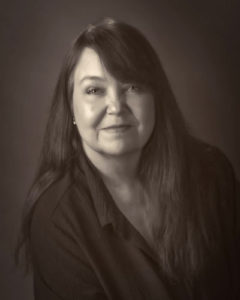 Malinda Julien is a commercial food photographer and owner of Julien & Lambert Photography and Phood Photo in Fort Worth, Texas. Author of the Sugar Biscuit Journey and Home Cooking Kitchen cookbooks, Paved Paradise and ESSENTIAL books. Host of “Home Cooking Kitchen” YouTube™ channel. Instructor of photography through Julien & Lambert Photo Education. Her latest book, “Essentials,” can be seen in video on their website: www.JulienLambertPhoto.com/essential-the-book. It is also available on Amazon.
Malinda Julien is a commercial food photographer and owner of Julien & Lambert Photography and Phood Photo in Fort Worth, Texas. Author of the Sugar Biscuit Journey and Home Cooking Kitchen cookbooks, Paved Paradise and ESSENTIAL books. Host of “Home Cooking Kitchen” YouTube™ channel. Instructor of photography through Julien & Lambert Photo Education. Her latest book, “Essentials,” can be seen in video on their website: www.JulienLambertPhoto.com/essential-the-book. It is also available on Amazon.



